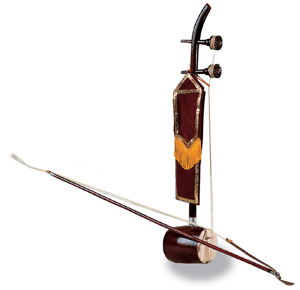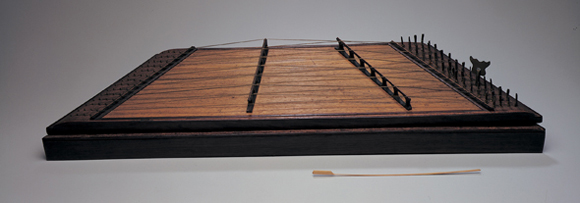|
|
|
 |
 |
 |
 |
| |
Instruments from which the sound comes when strings are vibrated are called string instruments. There are different kinds of string instruments. The geomungo, bipa, and guitar are string instruments with fixed bridges; the gayageum, seul and koto all have strings that are supported by movable bridges; and the wagonghu, sugonghu, and harp are open-string, bridgeless instruments. There are also different methods for making sounds on the instruments. The gayageum and harp are plucked instruments; the geomungo, hyangbipa, shamisen, and the balalaika are played with a plectrum; the ajaeng, haegeum, and violin are all played by a bow drawn across the strings; and a sound is produced on the yanggeum by a hammer-like stick that strikes the strings.
1.Gayageum (가야금)
It is said that the gayageum was made by King Gasil of the Gaya Kingdom, and so that is where its name originates. The gayageum is made of paulownia wood on which sets 12 moveable bridges. These bridges support the 12 strings made of twisted silk thread. The left hand presses the strings (shaking, bending, or vibrating them) to regulate the pitch while the right hand plucks or strums the strings. The gayageum is used in two different types of music and so there are different types of gayageum. There is the pungnyu gayageum (the original) that is used in jeongak and the sanjo gayageum that is used when playing folk music.
 |
 |
2.Geomungo (거문고)
It is said that the geomungo was created by the musician Wang San-ak during the Goguryeo period. The geomungo has six silk-thread strings that are stretched across the wooden body. Three of the strings are supported by fixed bridges, while the other three strings rest on by moveable bridges. The right hand plucks or strums the strings with the use of a suldae (plectrum), and the left hand controls the tuning by moving the bridges.
 |
 |
 3.Haegeum (해금) 3.Haegeum (해금)
The haegeum is a kind of string instrument that can be found throughout Asia. In Korea its use dates back to the Goryeo dynasty. The haegeum is played with a horsehair bow that is inserted between two strings stretched vertically over the resonant body. The right hand draws the bow between the two silk-thread strings called the junghyeon and yuhyeon. The left hand holds the two strings while the fingers of the left hand change the pitch by bulling in and out on the strings. |
 |
4.Ajaeng (아쟁)
The ajaeng is made of a wooden board on which 7-9 strings are stretched across bridges. The right hand draws a hwaldae (bow stick) across the strings, and the left hand presses and shakes the strings to adjust the pitch. With its low tone, it adds a dignified and solemn tone when played in ensembles. There are two kinds of ajaeng that are currently played: the jeongak ajaeng and the sanjo ajaeng.
 |
 |
5.Yanggeum (양금)
The name yanggeum literally means an instrument that was introduced from the West. Two bridges on the trapezoid-shaped body support wire strings and divide the instrument into three sections. The strings are struck with a thin bamboo hammer to produce sound.
 |
|
|
|
 |
|
|
 |
|
 |
 |
 |
 |
|
|
|
|